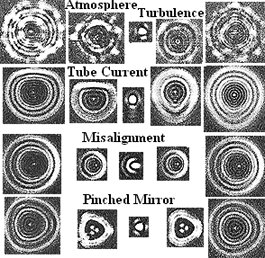|
Star testing your telescope : The most important thing about star testing a telescope is said that Star-test telescope using well corrected eyepiece ( preferably Nagler, Radian, Plossl or Ortho). Don't use diagonal or barlow in your tests (unless it is known without question, to be of very high quality). Give the scope a full two hours of cool-down time (or more if the scope has a long thermal equilibrium time or you live in a cold area) and make sure it is a night of good seeing, say 7 or better on a scale of 10. Focus on a 1st or 2nd manitude star using very high power (50x per inch). If you use a low magnification, such as only 20x - 25x per inch of aperture, you are desensitizing the test. The higher the test star is in the sky during testing, the better. Turn the focus knob slightly to one side, then slightly to the other side, of best focus. The star's fuzzy, out-of-focus diffraction rings should look the same on both sides of best focus. That is, they should be the same shape and have the same distribution of light inside them.
conditions can hide aberrations, and the poor seeing can mimic surface roughness on the optics. Atmospheric turbulence can also cause softening of the contrast in the ring pattern, outside of focus. This is due to focusing on the upper level turbulence. Just another reason to test on nights of good seeing. The contrast of the ring pattern on both sides of focus is a good indicator of smooth optics. This is important for detecting low contrast details on the planets, because telescopes can have quasi-perfect symmetry in the star test, but if the surfaces are rough, the images will not show high contrast. Anything that deviates from a clean, round Airy disk at best focus, assuming the telescope is collimated, no tube currents or temperature boundary layer problems above the mirror, fully cooled down (optically at null), and is tested during excellent seeing, is a sign of an optical aberration. You can also do the "snap" test, which is a subjective way to test optics, but still a good general test. If the star (or planet) snaps into focus without any ambiguity of focus, the optic is probably a good one. The same holds for high power viewing. A good optic can stand high magnification on a night of good seeing, and a poor one will get mushy at high powers. Even if your telescope doesn't pass the star test with flying colors, please don't stop enjoying your telescope, and don't worry about the star test too much, unless it shows very obvious errors. Again, no optic can pass the star test perfectly. What really counts is how it performs in focus. If your telescope shows highly detailed lunar and planetary images, you have a very fine optic. |


